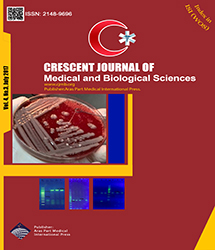
| Original Article | |
| Totally Implantable Venous Access Port Infection in Northwest of Iran | |
| Dawood Aghamohammadi1, Solmaz Fakhari2, Eissa Bilehjani3, Yahya Ataei4, Marzie Jafari5 | |
| 1Associated Professor in Anesthesiology, Fellowship in Palliative Care Medicine, Pain and Palliative Care Department, Imam Reza Hospital, Tabriz University of Medical Sciences, Tabriz, Iran 2Assistant Professor in Anesthesiology, Fellowship in Palliative Care Medicine, Pain and Palliative Care Department, Imam Reza Hospital, Tabriz University of Medical Sciences, Tabriz, Iran 3Assistant Professor in Anesthesiology, Anesthesiology Department, Madani Hospital, Tabriz University of Medical Sciences, Tabriz, Iran 4Anesthesiologist, Fellowship in Palliative Care Medicine, Pain and Palliative Care Department, Imam Reza Hospital, Tabriz University of Medical Sciences, Tabriz, Iran 5MD, Faculty of Medicine, Tabriz University of Medical Sciences, Tabriz, Iran |
|
|
CJMB 2017; 4: 126–130 Viewed : 5155 times Downloaded : 4339 times. Keywords : Totally implantable venous access port, Chemotherapy, Infection, Complication, Cancer |
|
| Full Text(PDF) | Related Articles | |
| Abstract | |
Objectives: The totally Implantable Venous Access Ports (TIVAPs) are widely used for chemotherapy, parenteral nutrition, blood sampling, infusion or injection. They are suitable for long-term use and improve the patient"s quality of life; however they have some important complications. One of the most common complications is infection. We investigated the port infection rate as well as its risk factors. Materials and Methods: All patients with TIVAP who were admitted to the academic palliative care clinic for heparin flash, Haber needling or care of TIVAP, were enrolled in study. Patients" demographic, sociodemographic data and clinical signs and symptoms were collected by questionnaire and physical exam. Blood culture was performed from port access of patients. The port removed in any case with positive blood culture or other irresolvable problem. The collected data were compared between patients with or without port infection. Results: Out of 116 patients, 95 patients (81.9%) were female and 21 patients (18.1%) were male. The rate of infection was 5.2%. In 11 cases the port was removed during the study period. The total complication rate was 15.5%. There were not any correlations between type of malignancy, patients" level of education, previous chemotherapy and radiation therapy and the length of time of port implantation with port infection rate. Conclusions: The prevalence of the infection and total complication rate was 15.5%. and 5.2% respectively. Infection with Staphylococcus aureus was the most common reason. |
Cite By, Google Scholar
Google Scholar
PubMed
Online Submission System
 CJMB ENDNOTE ® Style
CJMB ENDNOTE ® Style
 Tutorials
Tutorials
 Publication Charge
Medical and Biological Research Center
About Journal
Publication Charge
Medical and Biological Research Center
About Journal
Aras Part Medical International Press Editor-in-Chief
Arash Khaki
Deputy Editor
Zafer Akan


















